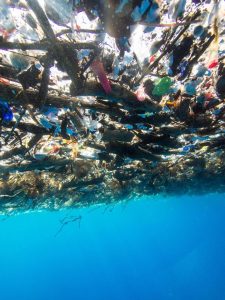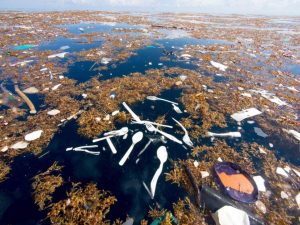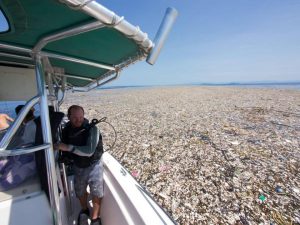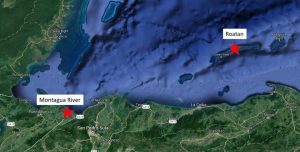Idyllic island of trash
 Idyllic Caribbean Island Covered In A Tide Of Plastic Trash Along Coastline
Idyllic Caribbean Island Covered In A Tide Of Plastic Trash Along Coastline
By Trevor Nace , CONTRIBUTOR From Forbes
Opinions expressed by Forbes Contributors are their own.
A diver as he gets ready to dive in the plastic wave along Roatan, an island off the coast of Honduras.
What was once an idyllic coastline along the shores of Roatan now is choked with tides of plastic waste. The Locals noticed that suddenly their coastline was inundated with plastic trash, from bags and bottles to plastic cutlery and packaging material.
It is thought that the plastic originated from the mouth of Guatemala’s Montagua River, which recently carried a wave of trash from Guatemala out to sea. The resulting location of the trash, from inland Guatemala, appears to be on the beaches and coastlines of Roatan. For residents of Roatan, a tiny island only 12 miles long by 3 miles wide, the task at hand of cleaning up their coastline will be difficult.
Photographer Caroline Power, who lives on Roatan, captured the plastic tide along the small island. Caroline recently shared the photos on social media in hopes that it would raise awareness to the issues surrounding plastic waste globally.
In Caroline’s post, she urges people around the world to think next time they use Styrofoam or plastic cutlery and the eventual destination of that plastic waste.
Plastic in our oceans has increasingly become a major health risk for humans and marine life. It is estimated that there are 51 trillion microplastic particles in our ocean, which are ingested by fish and marine birds. Eventually, those microplastics end up in the fish we eat.
Today, there are more than 8 million tons of plastic that enter the world’s oceans each year. At the current rate of plastic entering oceans, recent studies estimate that there will be more plastic in our oceans than fish, in weight, by 2050.
While the amount of plastic entering the world’s oceans continues to dramatically increase, we do see some efforts to both increase recycling rates and use of recycled materials. However, this increase will likely be offset by the need for more plastic bottles, bags, cutlery, etc. as global populations increase.
Plastics are non-biodegradable and often find their way, along with other waste, into waterways and oceans. When they enter the ocean plastics simply break down into smaller pieces until they turn into microparticles. These microparticles are naturally ingested by fish. It is estimated that 90 percent of seabirds have ingested plastic microparticles.
This will continue to be a challenge future generations must face as global populations continue to increase and consumption along with it. Thankfully, there are solutions to the use of plastics and we do have the technology to utilize more degradable packaging.
Trevor Nace is a geologist, Forbes contributor, founder of Science Trends, and adventurer. Follow his journey @trevornace.
IMAGES: Caroline Power Photography
A view of the plastic trash from underwater.
Plastic trash in the ocean nearby Roatan.
Plastic waste along the coastline of Roatan.
Google
Location of Roatan Island and the mouth of Montagua river in Guatemala.
For more on this story go to: https://www.forbes.com/sites/trevornace/2017/10/27/idyllic-caribbean-island-covered-in-a-tide-of-plastic-trash-along-coastline/#7a1d90e02524









